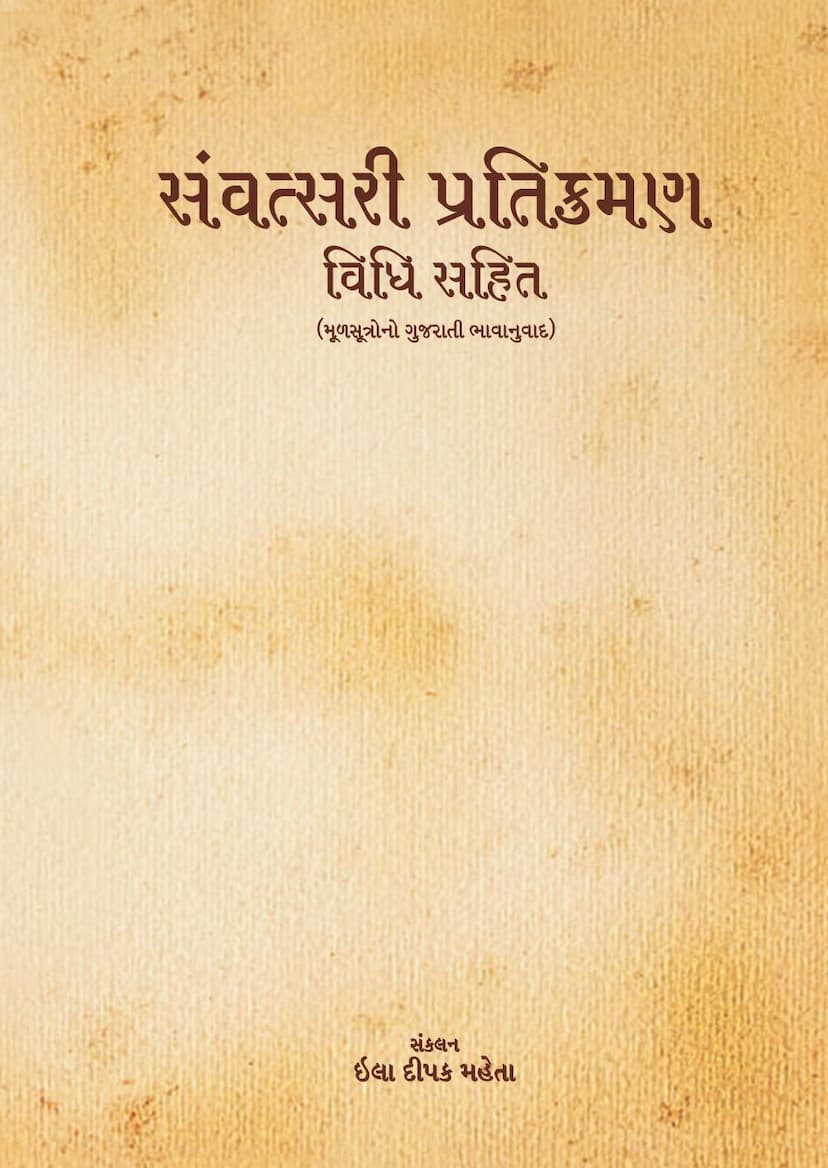Samvatsari Pratikramana Vidhi Sahit
Added to library: September 2, 2025

Summary
This Jain text, titled "Samvatsari Pratikramana Vidhi Sahit" (The Ritual of Annual Pratikramana with Procedures), compiled by Ila Dipak Mehta, is a comprehensive guide to performing the Samvatsari Pratikramana, a significant annual ritual in Jainism.
The book is dedicated to "Every seeker of the profound secrets of Jainism."
Key aspects and themes highlighted in the text include:
- The significance of Pratikramana: The text emphasizes that Pratikramana is a profound yogic practice aimed at purifying the mind and soul. It's described as a means to shed the burden of past karmas, attain mental peace, and turn inwards.
- Meaning of Pratikramana: The word "Pratikramana" is broken down into "Prati" (back) and "kramana" (moving), signifying a return or turning back. In a spiritual context, it means returning from the path of negative karmic influx (asrava) to the path of cessation and shedding of karmas (samvara and nirjara).
- The concept of "Swasthana" and "Parasthana": "Swasthana" (one's own place) refers to a state of stability in knowledge, perception, and conduct, living in one's true nature. "Parasthana" (another's place) represents the opposite – living under the influence of vices like violence, falsehood, theft, possession, anger, pride, deceit, and greed, essentially being engrossed in the eighteen places of sin. Pratikramana aims to bring the soul back to its Swasthana.
- Types of Pratikramana: The text explains different types of Pratikramana performed throughout the year:
- Rai Pratikramana: Performed daily in the morning to purify sins committed during the night.
- Dawasik Pratikramana: Performed daily in the evening to purify sins committed during the day.
- Pakshik Pratikramana: Performed every fifteen days for special purification.
- Choumasik Pratikramana: Performed every four months to gain liberation from sins accumulated knowingly or unknowingly.
- Samvatsarik Pratikramana: The main focus of the book, performed annually to atone for all sins of the entire year and to forgive and seek forgiveness from all beings.
- The Six Essential Actions (Aavashyak Kriyas) within Pratikramana:
- Samayika: A period of 48 minutes (two ghadi) dedicated to a virtuous, disciplined life, controlling sinful activities, and maintaining a pure and tranquil mind.
- Chattuvisattho (Logassa): Recitation praising the 24 Tirthankaras, believed to bring external and internal happiness, peace, health, and lead the soul towards liberation.
- Vandana (Su-guru Vandana): Respectful salutation to the spiritual guides who uphold vows of non-violence, truth, non-stealing, celibacy, and non-possession.
- Pratikramana: The act of self-reflection and confession of sins committed through mind, speech, and body, followed by seeking forgiveness.
- Kausagga: A practice of detachment from the body, enduring physical hardship, maintaining silence, and renouncing impure thoughts and tendencies through meditation.
- Pachchakkhan: Taking vows and resolutions to live a disciplined life, avoid bad habits, engage in virtuous conduct, and prevent karmic influx.
- Ritualistic Items and their Significance: The book details the use and meaning of various items essential for the ritual, such as:
- Sthapanacharya: An idol or book representing the Guru when the Guru is not physically present.
- Katasana (Asana): A woolen mat for maintaining purity and energy.
- Muhpatti: A cloth worn over the mouth to protect subtle beings and show respect to learned souls and knowledge.
- Charvalo (Ogha): A brush-like tool used for cleaning the ground.
- Detailed procedures and visuals: The book provides detailed explanations and illustrations for various ritualistic actions like "Khama-samana kem deve?" (How to prostrate for forgiveness?), "Kausagga kem karavo?" (How to perform Kausagga?), "Muhpatti padilehana" (cleaning the Muhpatti), and Guru Vandana, including specific mantras and mudras.
- The compiler's motivation: Ila Dipak Mehta shares her personal journey, motivated by a desire to understand the rituals for her daughters-in-law and sons, realizing the importance of understanding the underlying principles of these practices. She emphasizes the scientific and meaningful nature of these rituals.
- Endorsements: The book is supported by endorsements from esteemed figures like Padma Shri Dr. Kumarpal Desai and Dr. Dhanvant Shah, who highlight its value in making Jain rituals accessible and understandable, especially for the younger generation. They praise the author's dedication and contribution to Jain literature.
In essence, "Samvatsari Pratikramana Vidhi Sahit" is a practical, informative, and spiritually enriching guide that aims to deepen the understanding and practice of this vital Jain ritual, fostering a sense of pride and devotion towards the teachings of the Tirthankaras. It serves as a bridge between ancient scriptures and modern understanding, making the profound concepts of Jainism accessible to a wider audience.